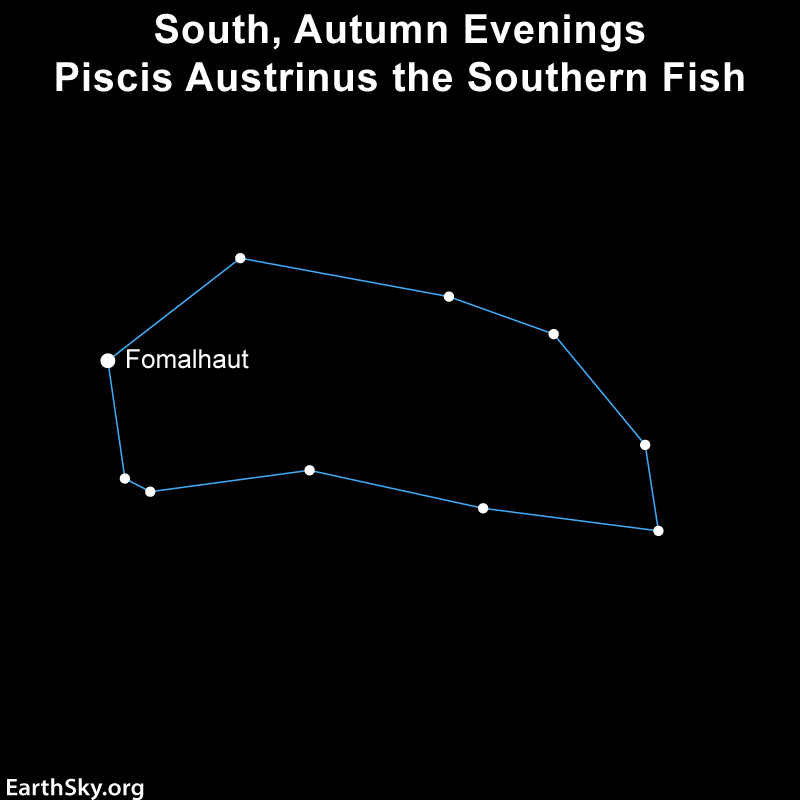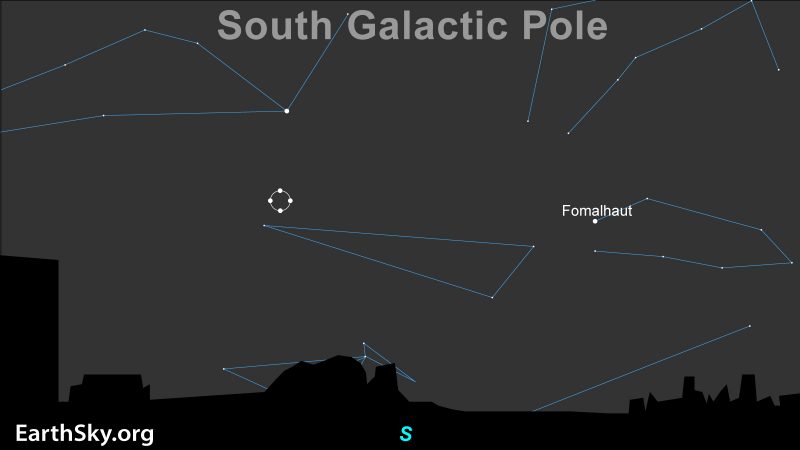
Gazing towards our galaxy’s south window into Intergalactic space
As you gaze toward the bright star Fomalhaut, you’ll be looking in the direction toward our galaxy’s south window. In other words, you’ll be looking away from the flat plane of our Milky Way, where most of our galaxy’s stars reside. And you’ll be looking in the direction toward one of the poles of our galaxy. Because, that’s where there are fewer stars, and beyond the Milky Way’s stars, there is intergalactic space.
As a matter of fact, you might say we’re looking out the south window of the galaxy.
Fomalhaut is the brightest star in the constellation Piscis Austrinus the Southern Fish.
Beware, though. The other two bright “stars” in the area in 2022 are the planets Jupiter and Saturn. Jupiter will be the brightest of the three and below the eastern side of the Great Square of Pegasus. Saturn will be the most westerly of the trio and a creamy golden color.
Note: To see a precise view from your location, try Stellarium Online.
The Milky Way’s south galactic pole

Why find Fomalhaut? When you look at this star – sometimes called the Loneliest Star – you are looking some 90 degrees from the plane of our galaxy’s equator.
Our Milky Way galaxy is round and flat, like a pancake. When you look toward Fomalhaut, you’re looking away from the pancake, and out the south window of the galaxy. In other words, we’re looking away from the star-packed disk of the galaxy, into intergalactic space and the realm of galaxies.
Want the exact location of the south galactic pole? It lies east of Fomalhaut, in the faint constellation Sculptor. See the chart above.
Finding Fomalhaut
Fomalhaut is a very noticeable star because it’s in a region of the heavens where there are few stars bright enough to be seen with the eye. That’s why Fomalhaut is often said to be the loneliest star. If you’re not sure, try using the Great Square of Pegasus to confirm the star you see is Fomalhaut. See the chart below.
Our galaxy’s south window from the Northern Hemisphere:
The Great Square of Pegasus appears high in the south to overhead by around 7 to 8 p.m. local time in late November and early December. This large asterism really does look like a large square pattern, with four medium-bright stars marking the corners. Draw a line through the Great Square’s two westernmost (or right-hand) stars, and extend that line southward to land on Fomalhaut.
From the Southern Hemisphere:
The Great Square of Pegasus appears low in the northern sky. Then draw your line from the two westernmost stars upwards to Fomalhaut. So, just take the chart below, and turn it upside-down!

Bottom line: Use the Great Square of Pegasus to locate Fomalhaut. And once you’ve found Fomalhaut, you’re on your way to visualizing looking out our galaxy’s south window into intergalactic space.
Easily locate stars and constellations during any day and time with EarthSky’s Planisphere.











